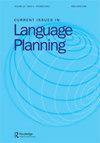Life sciences reading material in vernacular: lessons from developing a bilingual (IsiZulu and English) book on South African frogs
IF 1.8
1区 文学
Q2 EDUCATION & EDUCATIONAL RESEARCH
引用次数: 3
Abstract
ABSTRACT The discussion of African languages as languages of learning and teaching can be traced back to the 1980s. To date, this discussion still continues and efforts to intellectualise African languages have been lax. Here, we present practical South African examples of higher education achievements in African languages that demonstrate the challenges and opportunities of African language planning and corpus development. We particularly focus on the development of a peer-reviewed bilingual (IsiZulu and English) book on the frogs of Zululand, South Africa. The publication under consideration falls within the life sciences, and it is the first comprehensive book on South African frogs to be written in an African language. Developing life sciences reading material in vernacular is a time-consuming process that requires a multidisciplinary team which understands both life and social sciences. Furthermore, when vocabulary relating to a focal species is undocumented, field research is necessary to identify the nuances of a specific language or culture. This language planning effort under discussion demonstrates the IsiZulu language’s ability to communicate life sciences and how language planning efforts can be made integrative and inclusive of previously marginalised languages.当地的生命科学读物:编写一本关于南非青蛙的双语(伊西祖鲁语和英语)书的经验教训
关于非洲语言作为学习和教学语言的讨论可以追溯到20世纪80年代。迄今为止,这种讨论仍在继续,使非洲语言智能化的努力一直很松懈。在这里,我们展示了南非高等教育在非洲语言方面取得的成就,这些成就展示了非洲语言规划和语料库开发的挑战和机遇。我们特别关注一本关于南非祖鲁兰青蛙的同行评审双语(伊西祖鲁语和英语)书的开发。正在考虑的出版物属于生命科学,是第一本用非洲语言编写的关于南非青蛙的综合性书籍。用白话编写生命科学读物是一个耗时的过程,需要一个了解生命科学和社会科学的多学科团队。此外,当与重点物种有关的词汇没有记录时,有必要进行实地研究,以确定特定语言或文化的细微差别。正在讨论的这项语言规划工作展示了伊西祖鲁语交流生命科学的能力,以及如何使语言规划工作与以前被边缘化的语言融合和包容。
本文章由计算机程序翻译,如有差异,请以英文原文为准。
求助全文
约1分钟内获得全文
求助全文
来源期刊

Current Issues in Language Planning
Multiple-
CiteScore
4.80
自引率
16.70%
发文量
26
期刊介绍:
The journal Current Issues in Language Planning provides major summative and thematic review studies spanning and focusing the disparate language policy and language planning literature related to: 1) polities and language planning and 2) issues in language planning. The journal publishes four issues per year, two on each subject area. The polity issues describe language policy and planning in various countries/regions/areas around the world, while the issues numbers are thematically based. The Current Issues in Language Planning does not normally accept individual studies falling outside this polity and thematic approach. Polity studies and thematic issues" papers in this journal may be self-nominated or invited contributions from acknowledged experts in the field.
 求助内容:
求助内容: 应助结果提醒方式:
应助结果提醒方式:


